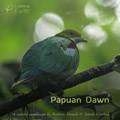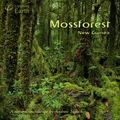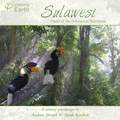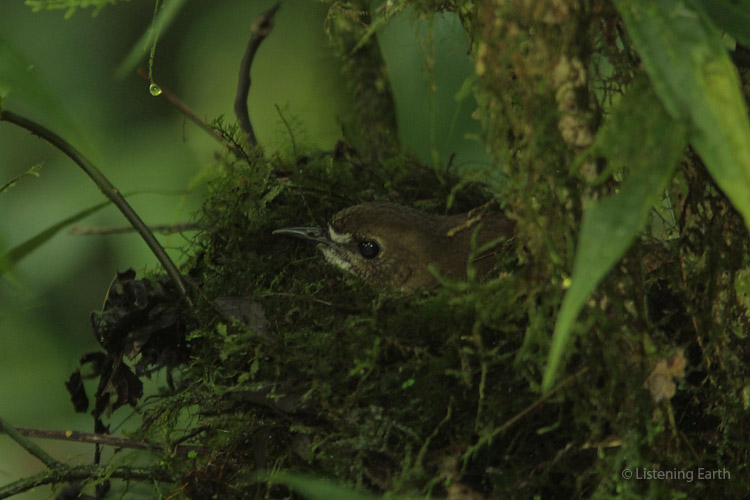

Running Time:
240 min
Release Date:
April 2019
Recording Location:
Camp Astrapia, north of Gomdan Village, YUS Conservation Area, Huon Range, Papua New Guinea
If you like this album,
we also recommend:
The Melodious Forest - Papua New Guinea's Uplands
We call it birdsong, but only a few bird species have vocalisations that are truly melodic. This leads to many habitats being dominated by twittery or even raucous birdsong, and to us, those few tuneful species stand out for their unusually musical voices.
The upland forests of Papua New Guinea however, seem unusually rich in birds with melodic voices. These mountain rainforests resound with tuneful birdsong.
Lesser Ground Robins are the most noticeable, singing loudly and sweetly with graceful, melodic phrases. Various other robin species each have their own simpler songs, some medium-pitched, and others so high as to sound quite un-bird-like. Friendly Fantails (that is actually their species name, and its our cover bird) sing delicate arpeggio patterns, while their cousin Black Fantails give boisterous cascades of notes. Whistlers, Pitohuis and Boatbills add to the layering of sounds. Meanwhile Spotted Jewel Babblers call from the forest floor with a steady chiming on a single note that acts like a tonal centre to the other species.
There are exceptions of course. Wahnes's Perotia is a textural contrast with loud and harsh screeches, while small groups of lorikeets skitter noisily among the treetops. Underpinning all these are fruit doves and pigeons with their lovely, booming calls.
You can understand why I think of these as the melodious forests!
This recording takes us high in the mountains, to over 2000 metres. This is still well below the cloudforest, and many of the species here are unique to these mid-altitude forests. The album is one continuous, 4-hour recording, allowing us to hear the rich diversity of highland Papuan birdsong.
Andrew comments:
"This recording was made during a field trip to Papua's Huon Peninsular organised by fellow members of the Australian Wildlife Sound Recording Group. See here for an overview of this expedition.
"With the assistance of local villagers as guides and porters, we had established a base in the heart of a remote area - Camp Astrapia. From this camp, I'd set out on my own each morning to record and explore, and after a few days I was closing in on the best sites for recording. However this was our last camp at the end of a long, strenuous trip, and I was physically and emotionally exhausted.
"On our second last night, I went to sleep to the sound of rain that had been falling since mid afternoon. Everything was sodden. In the small hours of the morning, I was awoken by an earthquake, the ground shuddering beneath me. Seconds later, came the sickening groan and crash of a large tree falling on the edge of camp. Our local guides were up immediately, calling out, torches flashing, assessing the situation, and then hacking away with machetes to clear the debris.
"Tired, a bit jolted, I was not at all feeling like going out into the wet dawn to record, even if the rain had stopped. But I couldn't get back to sleep, and eventually realised that my second last morning was not an opportunity to miss, particularly after the exertion to get here. So I arose, but feeling rattled and just wanting some reassuring company, I asked one of our guides, George, to accompany me that morning.
"We negotiated the chaos of the treefall, which was frighteningly only a few metres from where we'd been sleeping, and set off along slippery jungle tracks. For half an hour we pushed through glistening wet vegetation in the dark. I was aiming for a barely discernible foot track I'd found the previous day, which led over the ridgetop to a shallow basin, forming a small amphitheatre.
"Once there, George watched me set up my microphones in the dark, switch on, and together we stood a few hundred meters away while the forest woke up. And what a glorious dawn chorus it was. After that first flush of the day's birdsong subsided, I suggested George return to camp and get himself something more substantial for breakfast than a banana.
"The daylight and birdsong had refreshed my spirits, and I remained, leaving the recorder going. I pottered around listening, at one point catching a rare glimpse of shy Jewel Babblers in the undergrowth. Eventually I wandered off to check out some other locations, and try photographing birds in the dense canopy. It was midday by the time I returned, finding the recorder still ticking away faithfully.
"So I had six hours of recording from that morning. The exhilarating dawn chorus turned out to be overwhelming on playback. It was just too much! So for this album, we begin in the lull after the chorus finishes, and continue through to the point when things had quietened in late morning."
Audio sample of this album
|
1. |
After the Dawn |
7.18 |
|
2. |
Friendly Fantail |
10.27 |
|
3. |
Spotted Jewel Babbler |
10.26 |
|
4. |
Lesser Ground Robin |
9.53 |
|
5. |
Black-throated Robin and Stellas Lorikeets |
5.00 |
|
6. |
Black-capped Robin |
11.02 |
|
7. |
A Distant Regent Whistler |
6.04 |
|
8. |
Black Fantail |
6.20 |
|
9. |
Wahnes's Perotia |
4.49 |
|
10. |
Mountain Fruit Dove |
4.53 |
|
11. |
Papuan Mountain Pigeon |
3.03 |
|
12. |
Brown-backed Whistler |
1.52 |
|
13. |
Blue-capped Ifrit |
9.12 |
|
14. |
Cinnamon-browed Melidectes |
1.46 |
|
15. |
Blue Grey Robin |
6.39 |
|
16. |
A Community of Lesser Ground Robins |
7.53 |
|
17. |
Papuan King Parrot Flies Past |
16.14 |
|
18. |
Black-billed Cuckoo Dove |
10.00 |
|
19. |
Stellas Lorikeets |
10.56 |
|
20. |
Black-breasted Boatbill |
19.26 |
|
21. |
New Guinea Scrubfowl |
10.48 |
|
22. |
Large Scrubwren |
19.09 |
|
23. |
Tit Berrypeckers and Black Pitohui |
14.16 |
|
24. |
Brush Cuckoo |
15.29 |
|
25. |
Rufous-naped Bellbird |
9.54 |
|
26. |
Rufous-backed Honeyeater |
6.35 |
Purchase this
album as:
Digital Album
(for immediate download)
Download this album
for as little as
$7.50 -
View Special Deals
(Prices AU$, exGST)
Mp3:
Mp3 is a universal audio format, playable on iPods, computers, media players and mobile phones.
Mp3 is a compressed format, allowing smaller filesizes, offering faster download times and requiring less storage space on players, but at some expense to the audio quality. Many listeners can't really hear the difference between mp3 and full CD-quality audio, and hence its convenience has lead to it becoming the default option for audio.
Our albums are generally encoded at around 256kbps (sometimes with VBR), balancing optimal audio quality without blowing out filesizes excessively. We encode using the Fraunhoffer algorithm, which preserves more detail in the human audible range than the lame encoder.
Our mp3 files are free of any DRM (digital rights management), so you can transfer them to any of your media technology. You've paid for them, they're yours for your personal use without restriction.
Mp3 files can be burned to disc, either as an mp3 disc, or an audio CD after converting them to a standard audio (.wav or .aif) format first.
FLAC:
FLAC is a high-quality audio format, allowing CD-resolution audio. It is ideal if you wish to burn your files to a CDR, or listen over a high resolution audio system. However files usually require special decoding by the user before playing or burning to disc.
FLAC (Free Lossless Audio Codec) is a LOSSLESS compressed audio format. This means that it preserves the full audio quality of a CD, but optimises the filesize for downloading. Typically, file sizes of around 60% are achieved without any degradation or loss of audio quality from the source files at the CD standard of 16bit/44.1kHz.
Obviously the file sizes are larger than for the mp3 version - usually around 300-400Mb for an album, compared to 100Mb for an mp3 album.
In addition, you'll need to know what to do with the files once you've downloaded them. In most cases you'll want to decode the files to wav or aiff, either to import into programs like iTunes, or burn to CDR. Some programs will play flac files natively.
There is a lot of information about flac online (eg: http://flac.sourceforge.net/)





 Alternate audio link
Alternate audio link 